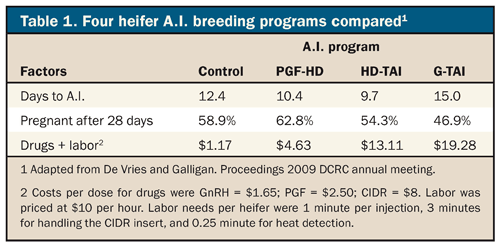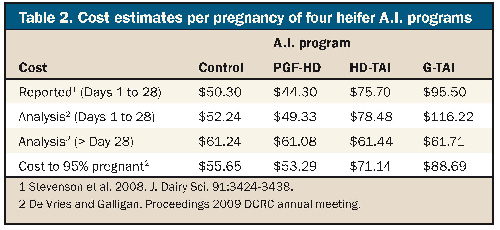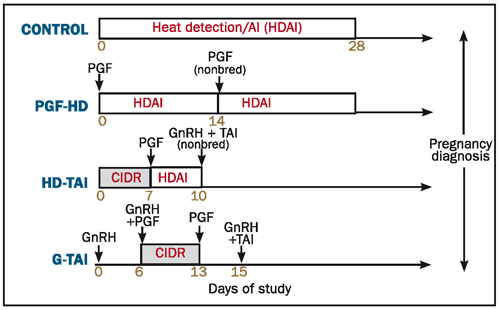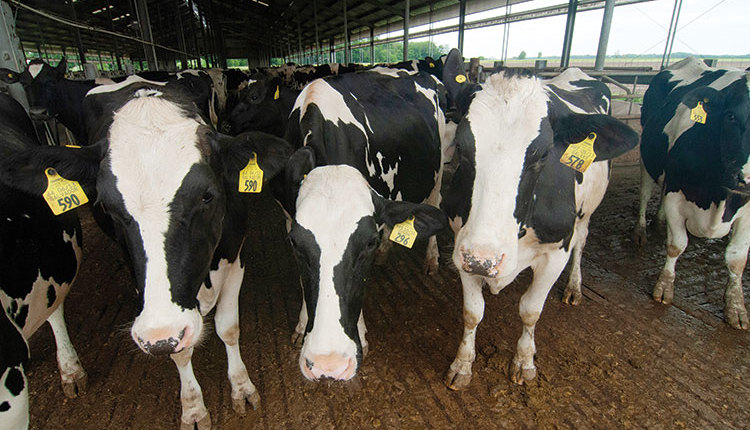The author is a professor of animal sciences at Kansas State University, Manhattan.
At the 2009 Dairy Cattle Reproduction Council meetings, Albert De Vries and David Galligan teamed up to describe the economic principles behind timed A.I. programs. In this column, we will look at the concepts that apply to heifer breeding programs and their relative costs.
The most commonly used A.I. breeding program for dairy heifers involves estrus detection. Heifers generally show very good heats and are easily detected if daily observations are made by astute observers. A reproductive program is a sequence of insemination opportunities. Each opportunity affects the cost of the breeding program and consists of four factors: (1) costs for drugs, semen, and labor; (2) days from start of breeding (enrollment in a synchronization program) to insemination; (3) fertility of each A.I. breeding; and (4) time between inseminations.
Some key assumptions
The number of days from breeding to conception (days open) depends on the timing of insemination and fertility. For heifers, the cost per day open includes the rearing cost at the end of pregnancy. If all heifers start the breeding program at the same age, then rearing costs until that time are not relevant. Rearing costs during pregnancy were assumed to be similar for any reproductive program.
De Vries and Galligan examined the costs of four different heifer A.I. programs. These protocols are illustrated in the figure (adapted from Stevenson et al., 2008). The first two programs are based solely on heat detection (Control and PGF-HD); the third (HD-TAI) consists of a hybrid including both heat detection and timed A.I. The last program (G-TAI) involves timed A.I. with no heat detection.

The costs for each of the heifer A.I. programs are summarized in Table 1. Days to A.I. represent days from start of breeding (enrollment in the A.I. program) until A.I. occurred. Also shown are the conception after 28 days of the program and the drug and labor costs.
Total costs of the four reproductive programs for heifers were expressed as costs per pregnancy. The timed A.I. program costs per pregnancy were greater than for the heat detection programs in both the original analysis by the Idaho group (Stevenson et al., 2008) and spreadsheet analysis done by De Vries and Galligan (first two lines of Table 2, respectively).

The costs per pregnancy after A.I. program completion (line 3) were similar because all heifers were then inseminated based on signs of heat, and these costs are independent of the number of open heifers. The average cost per pregnancy for all heifers that conceived (comparisons among program costs in Line 4) was less variable for heifers that conceived at first A.I. This difference in cost per pregnancy applies to only heifers that conceived at first A.I., whereas the remaining heifers had a very similar cost per day open.
Comparing the results
Costs then were estimated comparing an all heat detection (control) program with those that applied one timed A.I. followed by all heat detection and A.I. (timed A.I. + HD).

De Vries and Galligan concluded that timed A.I. programs in heifers can be profitable when conception and heat detection rates are average compared to industry standards.
What are your costs of breeding heifers? Can you reduce your heifer A.I. breeding costs?
Click here to return to the Reproduction E-Sources
100910_606
At the 2009 Dairy Cattle Reproduction Council meetings, Albert De Vries and David Galligan teamed up to describe the economic principles behind timed A.I. programs. In this column, we will look at the concepts that apply to heifer breeding programs and their relative costs.
The most commonly used A.I. breeding program for dairy heifers involves estrus detection. Heifers generally show very good heats and are easily detected if daily observations are made by astute observers. A reproductive program is a sequence of insemination opportunities. Each opportunity affects the cost of the breeding program and consists of four factors: (1) costs for drugs, semen, and labor; (2) days from start of breeding (enrollment in a synchronization program) to insemination; (3) fertility of each A.I. breeding; and (4) time between inseminations.
Some key assumptions
The number of days from breeding to conception (days open) depends on the timing of insemination and fertility. For heifers, the cost per day open includes the rearing cost at the end of pregnancy. If all heifers start the breeding program at the same age, then rearing costs until that time are not relevant. Rearing costs during pregnancy were assumed to be similar for any reproductive program.
De Vries and Galligan examined the costs of four different heifer A.I. programs. These protocols are illustrated in the figure (adapted from Stevenson et al., 2008). The first two programs are based solely on heat detection (Control and PGF-HD); the third (HD-TAI) consists of a hybrid including both heat detection and timed A.I. The last program (G-TAI) involves timed A.I. with no heat detection.

The costs for each of the heifer A.I. programs are summarized in Table 1. Days to A.I. represent days from start of breeding (enrollment in the A.I. program) until A.I. occurred. Also shown are the conception after 28 days of the program and the drug and labor costs.
Total costs of the four reproductive programs for heifers were expressed as costs per pregnancy. The timed A.I. program costs per pregnancy were greater than for the heat detection programs in both the original analysis by the Idaho group (Stevenson et al., 2008) and spreadsheet analysis done by De Vries and Galligan (first two lines of Table 2, respectively).

The costs per pregnancy after A.I. program completion (line 3) were similar because all heifers were then inseminated based on signs of heat, and these costs are independent of the number of open heifers. The average cost per pregnancy for all heifers that conceived (comparisons among program costs in Line 4) was less variable for heifers that conceived at first A.I. This difference in cost per pregnancy applies to only heifers that conceived at first A.I., whereas the remaining heifers had a very similar cost per day open.
Comparing the results
Costs then were estimated comparing an all heat detection (control) program with those that applied one timed A.I. followed by all heat detection and A.I. (timed A.I. + HD).
- Increasing rate of heat detection in the control program from 50 to 90 percent reduced the cost per pregnancy from $246 to $118, emphasizing the importance of heat detection.
- In the timed A.I. + HD program, as conception of each A.I. rose from 45 to 65 percent, the cost per pregnancy fell from $153 to $106.
- When conception was held constant at 55 percent, decreasing the days from start of breeding to A.I. from 15 to 5 days reduced cost per pregnancy from $142 to $115.
- Holding constant conception per A.I. at 55 percent and days to first A.I. at 10 days, and raising the cost of drugs and labor from $10 to $20 resulted in a higher cost per pregnancy from $123 to $133.
- The timed A.I. + HD program that required 10 days to first A.I., $15 for drugs and labor, assumed a 55 percent conception rate, and 21 days to the next insemination opportunity had a cost of $128 per pregnancy of which $28 was for semen, drugs, and labor.
- When applying the control heat detection (70 percent) only program, the cost per pregnancy compared with the previous timed A.I. scenario was an additional $39. Thus, a control heat detection program needed to achieve 84 percent heat detection to generate a $128 cost per pregnancy of the one timed A.I. program.
- If heat detection rate was 90 percent after the timed A.I. + HD option, the cost per pregnancy was $109. The control heat detection program needed to achieve 96 percent to generate the same cost per pregnancy. If the heat detection was only 50 percent after the timed A.I. + HD program, the cost rose to $169. The same cost was achieved for the control heat detection only program with only 69 percent detection. Thus, the timed A.I. + HD program allows for a lesser heat detection rate after first timed A.I. than a heat detection program with the same cost per pregnancy.

De Vries and Galligan concluded that timed A.I. programs in heifers can be profitable when conception and heat detection rates are average compared to industry standards.
What are your costs of breeding heifers? Can you reduce your heifer A.I. breeding costs?
100910_606










